Mulch provides warmth, protection, and nourishment for crops. It’s not just a simple layer of material; it’s a vital component that boosts the health and productivity of your garden.
Mulch acts as a shield against the harsh elements. It protects the soil from extreme temperatures, preventing it from getting too hot or too cold. This stable environment encourages healthy root growth and protects delicate plant roots from damage.
Mulch also helps to conserve moisture. It absorbs water and holds it in the soil, reducing the need for frequent watering. This is crucial during hot summer months when water evaporates quickly, leaving your plants parched and thirsty.
The best part is mulch suppresses weeds while improving the look of the vegetable garden. It prevents weed seeds from germinating and competing with your vegetables for nutrients and space. This means less time spent pulling weeds and more time enjoying your garden’s bounty.
Mulch materials will vary, and not all will suit a vegetable garden. Below is a list of mulch materials that are perfect for vegetable gardens of any size:
Best Vegetable Garden Mulches
Salt Hay and Straw
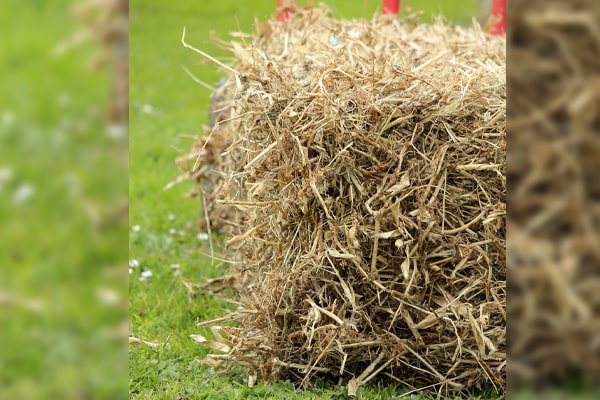
Salt hay and straw are excellent mulch options for vegetable gardens. They provide good insulation for the soil, keeping it warm in cooler weather and cooler in hotter weather. They also help retain moisture, reducing the need for frequent watering.
Hay and straw also create air pockets within the soil. These air pockets are crucial for the health of vegetable roots, as they allow oxygen to reach the root zone. Adequate oxygenation is essential for root respiration and nutrient uptake, promoting vigorous growth and overall plant health.
Additionally, salt, hay, and straw break down slowly, adding nutrients to the soil over time. These nutrients, such as nitrogen, phosphorus, and potassium, are essential for plant growth and development.
Grass Clippings
Do you mow your lawn? Save the grass clippings and use them as mulch for vegetable beds. Grass clippings are readily available, they’re free if you mow your lawn, and they suppress weeds effectively.
Grass clippings effectively conserve moisture in the soil by acting as a barrier that slows down water evaporation. This moisture retention is particularly beneficial during hot and dry periods when plants are more susceptible to drought stress. Consistent moisture levels in the soil support healthy plant growth and development, leading to higher yields and better quality produce.
One important thing to consider if you’re using grass clipping as much – do not to use clippings from lawns treated with herbicides. Clippings from chemically treated lawns may contain residues of these substances, which can potentially harm vegetable plants and soil organisms. Use only grass clippings from untreated lawns.
Fallen Leaves
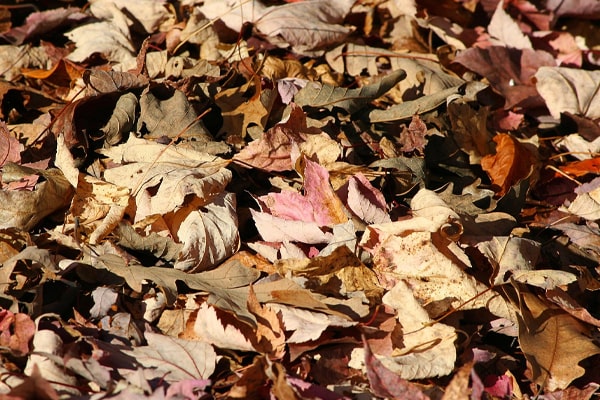
Fallen leaves are a natural and abundant mulch source. They provide insulation, moisture retention, and weed suppression.
When spread over the soil surface, fallen leaves create a protective barrier that helps regulate soil temperature. This insulation is particularly beneficial during colder months, as it prevents frost heaving and protects plant roots from freezing temperatures.
Similarly, in hot weather, the mulch layer helps to keep the soil cooler, reducing heat stress on plants.
As fallen leaves decompose over time, they break down into organic matter, enriching the soil with essential nutrients such as carbon, nitrogen, phosphorus, and potassium. These nutrients promote healthy growth and robust yields.
If you’re using fallen leaves as mulch, don’t forget to shred the leaves before using them to prevent the leaves from matting together and restricting airflow to the soil. Shredding the leaves speeds up decomposition and ensures better incorporation into the soil, maximizing their benefits for the garden ecosystem.
Paper
Paper is an eco-friendly mulch option that’s readily available and inexpensive. It suppresses weeds effectively and retains moisture well. Shredded newspaper or cardboard works best, and they break down gradually, adding organic matter to the soil.
Just like most of the mulch materials in this list, paper is porous so it allows water to be absorbed by the soil gradually. Its porous nature allows it to absorb and hold water, preventing rapid evaporation and maintaining consistent soil moisture levels. This moisture retention is particularly beneficial during hot and dry periods when plants are more susceptible to drought stress.
Paper mulch is its gradual decomposition over time. As shredded newspaper or cardboard breaks down, it adds organic matter to the soil, enriching its fertility and structure. This decomposition process releases valuable nutrients into the soil, such as carbon, nitrogen, and phosphorus, which are essential for plant growth and development.
When using paper mulch, it’s best to shred the newspaper or cardboard into smaller pieces for faster decomposition and ensure better incorporation into the soil. Also, try wetting the paper mulch thoroughly before applying it to the garden bed to prevent it from blowing away in the wind.
Woody Materials
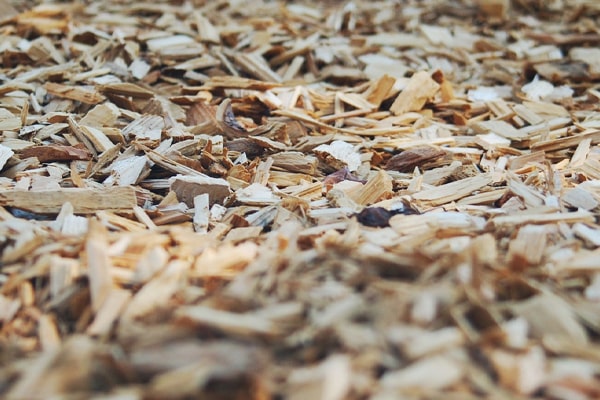
Woody materials, such as wood chips, pine bark nuggets, and liquorice roots, offer unique advantages as mulch in vegetable gardens. These materials, derived from trees and shrubs, provide a durable and long-lasting option for mulching, offering both functional and aesthetic benefits to the garden ecosystem.
Woody materials are effective in suppressing weeds. The dense, fibrous material inhibits the germination and growth of weeds by blocking sunlight and preventing weed seeds from establishing themselves.
Woody materials are also porous, so they absorb and hold water very well. Water is then released into the soil gradually, preventing soggy conditions. Moisture retention is particularly beneficial during dry periods, helping to maintain consistent soil moisture levels and reducing the risk of drought stress on vegetable plants.
As woody materials break down, they release nutrients like carbon, nitrogen and phosphorus back into the soil. This gradual breakdown of woody mulches improves soil health, promotes microbial activity, and encourages the formation of humus, resulting in fertile and nutrient-rich soil.
One thing to be mindful of is the potential nitrogen depletion when using woody materials as mulch.
As these materials break down, they may temporarily tie up nitrogen from the soil as microorganisms utilize it for decomposition. To mitigate this issue, it’s advisable to supplement woody mulches with nitrogen-rich fertilizers or organic amendments, ensuring that plants have an adequate supply of nitrogen for optimal growth and productivity.
Landscape Fabric
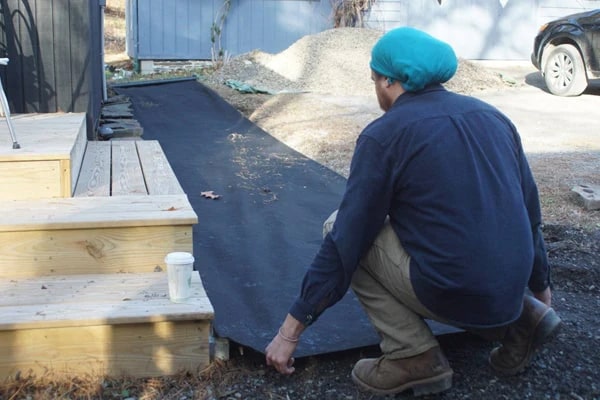
Landscape fabric is a synthetic material commonly used as mulch in vegetable gardens for its excellent weed suppression and moisture retention capabilities.
Made from durable materials such as polypropylene, landscape fabric forms a barrier on the soil surface, preventing weed growth by blocking sunlight and inhibiting weed seed germination. This effective weed control helps maintain a clean and tidy garden bed, reducing the need for tedious and time-consuming manual weeding.
Landscape fabric excels at retaining moisture in the soil, making it particularly beneficial in areas with hot and dry climates. By forming a barrier that slows down water evaporation, landscape fabric helps to maintain consistent soil moisture levels, reducing the frequency of irrigation and minimizing water wastage.
Looking for best quality landscape fabric? Buy your premium landscape fabric weed barrier from ECOgardener!
The material is highly durable and long-lasting. Unlike organic mulches that decompose over time, landscape fabric maintains its integrity for several years, providing reliable weed control and moisture management season after season. Its durability makes it a cost-effective mulching option, as it requires less frequent replacement compared to organic mulches.
Gravel and Pebbles
Gravel and pebbles are non-organic mulch options that provide excellent weed suppression and drainage. They’re long-lasting and low maintenance, but they don’t add nutrients to the soil like organic mulches do. It’s crucial to use a weed barrier underneath to prevent weeds from growing through.
Apart from suppressing weeds effectively, gravel and pebbles provide exceptional drainage, which will work best for clay or heavy soils. The porous pebbles allow water to pass through easily, preventing water from pooling on the soil surface and reducing the risk of root rot and other moisture-related issues. This improved drainage promotes healthy root growth and overall plant vigor, contributing to better plant performance and productivity.
Best of all, gravel and pebbles will last a long time and take minimal maintenance.
Unlike organic mulches that need to be replenished periodically as they decompose, gravel and pebbles remain intact for years, providing consistent weed suppression and drainage benefits season after season. Their durability makes them a cost-effective choice for gardeners looking for a low-maintenance and long-term mulching solution.
Choose Your Mulch Type According to Crops and Season
Best Mulch for Spring
For spring, your vegetable garden will need mulch that improves soil structure and boost nutrients:
- Leaf Mold
- Compost
- Woody materials
- Rotted manure
Best Mulch for Summer
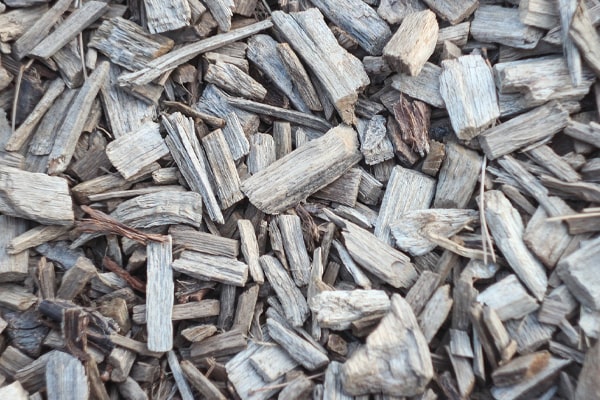
For summer, the vegetable garden will need mulch materials that lower soil temperature and prevent water evaporation. These materials are best for summer mulching:
- Woody materials (wood chips and shredded tree bark)
- Leaf mold
- Straw and hay
- Grass Cuttings
- Paper mulch
Best Mulch for Fall
Effective insulation is the goal for the fall season when the temperature is dropping and the soil becomes harder to work. These mulch will help balance the soil temperature while protecting the crops from the harsh winds.
- Fallen leaves
- Straw and hay
- Woody materials (wood chips and shredded tree bark)
Best Mulch for Winter
A protective barrier of mulch helps insulate the soil, and protect from frost, and harsh winds. These mulch materials will also boost soil fertility even as temperatures drop:
- Hay and straw
- Compost
- Well-rotted manure
- Woody materials
Maintaining Mulch in Your Vegetable Garden
Maintaining mulch in your vegetable garden is essential for keeping your plants healthy and thriving. Here are some tips to maintain mulch in garden beds:
Top it Up: One of the most important aspects of maintaining mulch in your vegetable garden is keeping it adequately topped up. Over time, mulch may break down or get displaced due to weather conditions or gardening activities.
Replenishing the mulch layer regularly maintains its thickness and effectiveness in suppressing weeds and retaining moisture. Aim to add a fresh layer of mulch as needed, typically once or twice a year, to keep your garden beds adequately covered.
Regular weeding: While mulch helps suppress weed growth, some weeds may still manage to poke through the mulch or germinate on its surface. It’s a must to pull any weeds that sprout in the garden beds. Regular weeding not only prevents weeds from competing with your vegetable plants for nutrients and space but also helps maintain the aesthetic appeal of your garden.
Check the beds’ moisture level: Mulch plays a crucial role in retaining soil moisture. But during hot and dry periods, it may need extra assistance. If you notice that the soil beneath the mulch is becoming dry, consider watering your garden beds more frequently to ensure that your plants receive an adequate water supply. Also, adding a thicker layer of mulch can help further conserve moisture and reduce the need for excessive watering.
Fluff the mulch: Over time, mulch may settle and become dense, hindering water penetration and air circulation in the soil. Always fluff or stir the mulch to prevent it from becoming compacted. By gently fluffing or stirring the mulch with a rake or garden fork, you can loosen it up and promote better airflow and drainage in your garden beds. This practice also helps distribute nutrients more evenly throughout the soil, ensuring that your plants receive the essential elements they need for healthy growth.
Check for pests and diseases: Some pests, such as slugs or snails, may hide under mulch during the day and emerge at night to feed on your plants. Regularly inspect your garden beds for signs of pest infestation, and take appropriate measures to control them if necessary. Similarly, keep an eye out for any fungal diseases that may develop in your mulch or on your plants, and promptly address them to prevent further spread.
Check for waterlogging: While mulch helps retain moisture in the soil, excessive water accumulation can lead to problems if not properly managed. Ensure that your garden beds are well-drained by incorporating organic matter into the soil and avoiding overwatering. Additionally, periodically check for any signs of water pooling or soil compaction and take corrective action as needed to maintain optimal soil conditions for your vegetable plants.
Mulching has many benefits for plant health and productivity. But the factors we’ve outlined above should be considered just to make sure you’re using the right materials for your vegetable garden.



